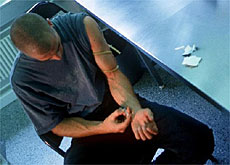Ten years of heroin handouts fixes drug crime

It’s been ten years since heroin addicts in Switzerland started getting their fixes from the state.
The “harm reduction” policy has attracted criticism but its supporters say it has achieved its goals of keeping addicts off the streets and reducing crime.
The scheme provides industrially-manufactured heroin to addicts under strict medical supervision.
At the start of 2003, more than 1,200 addicts were registered in the programme, which prevents participants from taking the drug home.
All patients have to satisfy strict criteria before they are accepted on the scheme. They must prove they have failed under other drug-withdrawal regimes and must be over 18 and have serious health and social integration problems.
During a conference to mark the scheme’s tenth anniversary, Arud Switzerland, an umbrella organisation committed to reducing harmful drug use, said the past decade had been very successful.
“[We have] stabilised the number of heavily-dependent addicts and we’ve also protected society from the impact of heroin addiction,” said Athos Staub, Arud’s president. “The scheme has managed to reach a group of patients that were not reached previously and the drop-out rate is low.”
Staub added that drug-related crime rates had dropped and the rate of infection from HIV among drug users had fallen, probably because many addicts were no longer sharing needles and were using supervised facilities to shoot up.
Abstinence
For the Federal Health Office, the scheme’s benefits are clear.
Of between 180 and 200 patients a year who leave the programme, between 35 and 45 per cent go on to methadone-assisted withdrawal schemes. Around 25 per cent decide to undergo abstinence therapy.
There has also been a dramatic impact on crime, the Office says.
When they start on the programme, around 70 per cent of addicts earn money from illegal activities. After 18 months in treatment, the number goes down to 10 per cent.
No jobs
But there have been some failures too, notably in reintegrating drug users into the labour market.
“This is a difficult task to accomplish given the current state of economic downturn and companies laying people off,” Staub explained.
Heroin also continues to be a popular drug among users in Switzerland, with an estimated 30,000 users. Staub says one reason for this might be the country’s prosperity.
“There is a correlation between the affluence of society and the number of addicts,” he said.
Moral high-ground
The programme also has its detractors, including Swiss rightwing and religious groups, which argue that the overall goal – of getting addicts off drugs – has been forgotten.
They accuse the Swiss government on maintaining people on drugs, when it should favour abstinence programmes
The United Nations drugs watchdog, the International Narcotics Control Board (INCB), has also questioned the wisdom behind replacing illegal heroin with legally-prescribed heroin.
The INCB’s secretary, Herbert Schaepe, told swissinfo that the agency was not encouraging other countries to follow the Swiss example.
“It is an approach that is feasible only in a very limited number of countries which can afford it;” Schaepe said. “This programme is extremely expensive and, in times of limited resources, it has to be decided whether these resources can be spent elsewhere in a better and more productive way.”
But Staub argues that the programme makes economic sense.
“It costs SFr50 ($40) to treat one patient per day [which means] we save about SFr90 per patient in terms of costs [linked to] health and crime.”
Swiss model
Some countries, such as Britain and Canada, are already looking to the Swiss heroin-prescription model for ideas.
Nicola Metrebian, a research fellow at Imperial College London, told swissinfo that the Swiss approach was far more structured.
“In Britain, there are no eligibility criteria, no limits on dosage and patients are receiving heroin often on a daily basis for take home use,” she said.
There are currently around 450 patients receiving prescribed heroin in Britain and over 40,000 are on methadone-assisted withdrawal programmes. But the government has announced it wants to increase the number of heroin-prescription programmes.
Metrebian believes it may look to Switzerland for lessons.
swissinfo, Faryal Mirza
The Federal Health Office says the heroin-prescription scheme has led to a reduction in the spread of HIV and Aids and has helped people overcome their addiction.
After 18 months, the crime rate among drugs users on the programme also drops from 70% to 10%.
The decrease still persists after a treatment period of 4 years, the Office says.
There are around 30,000 heroin users in Switzerland.
More than 1,200 heavy heroin addicts receive their drugs under strict medical supervision.
There are 21 centres and two prisons taking part in the scheme.
It takes an average heroin addict 12 years to kick the habit.

In compliance with the JTI standards
More: SWI swissinfo.ch certified by the Journalism Trust Initiative










You can find an overview of ongoing debates with our journalists here . Please join us!
If you want to start a conversation about a topic raised in this article or want to report factual errors, email us at english@swissinfo.ch.